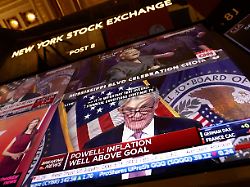Raise interest rates?
The US Federal Reserve is flying blind
By Jan Ganger
03/22/2023 06:59 am
Inflation is far too high while regional banks are struggling severely. US Federal Reserve Chairman Jerome Powell faces a difficult and risky interest rate decision.
The US Federal Reserve has to tackle two problems at the same time: high inflation and instability in the banking sector. The situation is particularly tricky because the classic anti-inflationary remedy – ie interest rate hikes – is causing major problems for regional US financial institutions in a complicated way.
This evening, German time, the central bank led by Jerome Powell will decide whether and by what amount interest rates will be increased further. The previous pace was sporty. It took the Fed less than 12 months to raise the interest rate range from near zero to the current level of 4.5 to 4.75 percent. It wants to get the high inflation under control. But she is slow to do so. Although the inflation rate has recently fallen to 6 percent, it is still well above the Fed’s target of 2 percent.
The logic behind interest rate hikes: They make credit more expensive and thus slow down both consumption and investment. This tends to dampen prices.
However, the pace pursued by the Fed has undesirable side effects. Regional banks are having a hard time – above all the Silicon Valley Bank (SVB), which was overwhelmed by it. She had only done what all banks do: she had invested customer deposits. In view of the many years of low interest rates, she had invested a large part in US government bonds. However, due to rapidly and sharply rising interest rates, they lost value rapidly and significantly.
This was initially a purely accounting effect, since the old bonds, which are still considered particularly safe, are still paying the agreed interest rates. The bank’s downfall was that management had not adequately hedged the risk of rising interest rates and that investors suddenly withdrew their money in droves out of fear – especially because a disproportionately large number of accounts at the bank were above the statutory insurance limit of $250,000. This brought the SVB to the brink of collapse. It was temporarily closed and placed under state control. But there was still a crisis of confidence in the banking system, and shares in financial institutions went on a rollercoaster ride.
Fed should become more cautious
In the meantime, peace has returned to some extent. In view of the turbulence, however, doubts have been growing in recent days as to whether the Fed is really going to raise interest rates again. Federal Reserve Chairman Powell had previously indicated that interest rates would be raised sharply by 0.5 percentage points. But that was before the banking crisis. An increase of just 25 basis points is now expected on the financial markets.
A slight increase in interest rates would relieve the banks somewhat. However, it is very unlikely that the Fed will therefore refrain from raising interest rates and take a break. Such an unannounced slam on the brakes could trigger turbulence on the financial markets, after all the Fed has so far wanted to leave no doubt that it will not let up in its fight against inflation.
What makes the task of the central bankers particularly tricky: The tension in the banking sector also has consequences for the rest of the economy and thus indirectly for inflation. The reason: it currently looks as if many banks will reduce their lending. They want to increase their capital buffer and reduce credit risk. But more restrictive lending tends to make borrowing more expensive for businesses and consumers, leading to less investment and consumption.
This tends to dampen prices – and thus inflation. Investment bank Goldman Sachs believes the tightening of lending standards would mean raising the Fed’s interest rate by 25 or 50 basis points.
In addition, there is a delay in interest rate hikes reaching their full effect. The rule of thumb is 12 to 18 months. This makes it even more difficult for the Fed to find the right pace of rate hikes, i.e. keeping inflation under control while minimizing collateral damage.
